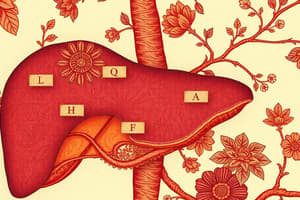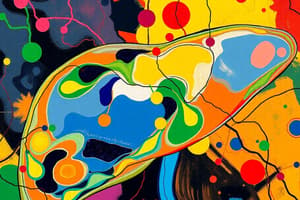Podcast
Questions and Answers
What is the approximate number of people worldwide who are G6PD deficient?
What is the approximate number of people worldwide who are G6PD deficient?
- 4 million
- 400 thousand
- 40 million
- 400 million (correct)
Which of the following is NOT a source of blood glucose in a normal person?
Which of the following is NOT a source of blood glucose in a normal person?
- Liver gluconeogenesis
- Fatty acids (correct)
- Liver glycogen
- Diet
What is the role of glucose in the liver during glycogen synthesis?
What is the role of glucose in the liver during glycogen synthesis?
- Glucose storage for other tissues (correct)
- Production of acetyl CoA
- Glucose for other tissues
- NADPH production
What is the byproduct of the pentose phosphate pathway?
What is the byproduct of the pentose phosphate pathway?
Why is gluconeogenesis not simply the reversal of glycolysis?
Why is gluconeogenesis not simply the reversal of glycolysis?
What is the trigger for haemolytic anaemia in people with G6PD deficiency?
What is the trigger for haemolytic anaemia in people with G6PD deficiency?
What is the source of blood glucose in conditions of carbohydrate deprivation?
What is the source of blood glucose in conditions of carbohydrate deprivation?
Which of the following is a glucogenic amino acid?
Which of the following is a glucogenic amino acid?
What is the effect of insulin on glycogen synthesis in the liver?
What is the effect of insulin on glycogen synthesis in the liver?
What is the effect of glucagon on plasma amino acids?
What is the effect of glucagon on plasma amino acids?
What is the primary source of energy for the brain?
What is the primary source of energy for the brain?
What is the effect of insulin on glucose uptake in muscle?
What is the effect of insulin on glucose uptake in muscle?
What is the primary fate of glucose in the liver during the fed state?
What is the primary fate of glucose in the liver during the fed state?
What is the effect of glucagon on fatty acid metabolism in the liver?
What is the effect of glucagon on fatty acid metabolism in the liver?
What is the characteristic of a glucose tolerance curve in diabetes type 2?
What is the characteristic of a glucose tolerance curve in diabetes type 2?
What is the primary metabolic pathway in erythrocytes?
What is the primary metabolic pathway in erythrocytes?
What is the primary function of glucose in the body?
What is the primary function of glucose in the body?
What is the normal physiological circulating glucose concentration in the blood?
What is the normal physiological circulating glucose concentration in the blood?
What is the consequence of glucose concentration dropping to 2.5 or less?
What is the consequence of glucose concentration dropping to 2.5 or less?
What is the role of glucose in the production of fatty acids and steroids?
What is the role of glucose in the production of fatty acids and steroids?
What is the advantage of glucose as a metabolic fuel?
What is the advantage of glucose as a metabolic fuel?
What is the primary pathway involving glucose in skeletal muscle?
What is the primary pathway involving glucose in skeletal muscle?
What is the function of glucose in adipose tissue?
What is the function of glucose in adipose tissue?
What is the consequence of glucose-6-phosphate dehydrogenase deficiency?
What is the consequence of glucose-6-phosphate dehydrogenase deficiency?
What is the role of the liver in glucose metabolism?
What is the role of the liver in glucose metabolism?
What is the result of high glucose concentrations in the blood?
What is the result of high glucose concentrations in the blood?
What is the primary function of insulin in the body?
What is the primary function of insulin in the body?
Which enzyme is responsible for the conversion of pyruvate to PEP in gluconeogenesis?
Which enzyme is responsible for the conversion of pyruvate to PEP in gluconeogenesis?
What is the primary function of glucagon in the body?
What is the primary function of glucagon in the body?
Which of the following reactions is reversible in glycolysis?
Which of the following reactions is reversible in glycolysis?
What is the primary source of substrate for gluconeogenesis during fasting?
What is the primary source of substrate for gluconeogenesis during fasting?
Which of the following hormones plays a crucial role in maintaining physiological blood glucose concentrations?
Which of the following hormones plays a crucial role in maintaining physiological blood glucose concentrations?
Flashcards are hidden until you start studying
Study Notes
Glucose Metabolism and the Liver
- Glucose is a vital metabolic fuel, essential for the body's functioning.
- The liver plays a crucial role in maintaining blood glucose homeostasis.
- Glucose is the preferred fuel source for all tissues, with some tissues having a continuous dependence on glucose.
Blood Glucose Concentration
- The normal physiological circulating glucose concentration is 3.9-6.2 mM.
- Average fasting blood glucose concentration is 4.4-5 mM for most adults.
- If blood glucose concentration drops to 2.5 or less, coma and death can result.
- If it rises for an extended period, dehydration, wasting of body tissue, and eventually death will result.
Roles of Glucose
- Glucose is a source of energy, generating 2 ATP through glycolysis and 31 ATP through oxidative phosphorylation.
- It is a source of NADPH, necessary for synthetic reactions, fatty acid synthesis, and drug metabolism.
- Glucose is a source of pentose sugars for synthetic reactions, such as nucleotide and DNA synthesis.
- It is a source of carbon for other sugars and glycoconjugates.
Advantages and Disadvantages of Glucose as a Metabolic Fuel
- Advantages: water-soluble, no carrier required in circulation, can cross the blood-brain barrier, and can be oxidized anaerobically.
- Disadvantages: relatively low yield of ATP/mole compared to fatty acids, osmotically active, and can cause direct cellular damage or accumulate toxic by-products in high concentrations.
Pathways Involving Glucose
- Predominant pathways involving glucose differ in various tissues.
- The liver can provide glucose for other tissues.
- Glucose is used in glycolysis, glycogen synthesis, and the pentose phosphate pathway in different tissues.
Role of Glucose in Different Tissues
- Skeletal muscle: glycolysis for anaerobic muscle contraction, glycolysis/TCA cycle for energy, and glycogen synthesis/degradation for energy storage.
- Heart/brain: glycolysis/TCA cycle for energy.
- Adipose tissue: glycolysis for production of glycerol phosphate for TAG synthesis.
- Erythrocyte: glycolysis for energy, pentose phosphate pathway for NADPH synthesis.
Glucose-6-Phosphate Dehydrogenase Deficiency
- X-linked hereditary disorder, affecting more than 400 million people worldwide.
- Triggers for hemolytic anemia in people with G6PD deficiency include favism, resulting from the ingestion of fava beans.
Gluconeogenesis
- Gluconeogenesis is the synthesis of glucose from non-carbohydrate sources in the liver.
- Sources: lactate, glycerol, other monosaccharides, and glucogenic amino acids (all except leu and lys).
- Not from fatty acids.
- Gluconeogenesis is not simply the reversal of glycolysis, with three irreversible reactions in glycolysis that must be bypassed.
Regulation of Gluconeogenesis
- Mobilization of substrate: glycerol from fat breakdown, amino acids from muscle protein breakdown.
- Activation of enzymes: G6Pase, F1,6bisPase, PEPCK, and pyruvate carboxylase.
- Regulation by insulin, glucagon, and adrenaline.
Blood Glucose Maintenance
- Insulin, glucagon, and adrenaline signal and coordinate the activities of the liver, adipose tissue, and muscle tissue to maintain physiological blood glucose concentrations.
- Insulin promotes synthesis and storage, while glucagon promotes degradation of stored fuel.
Insulin and Glucagon
- Insulin: anabolic hormone, promoting synthesis and storage.
- Glucagon: catabolic hormone, promoting degradation of stored fuel.
- Sites of insulin action: liver, adipose tissue, and muscle.
- Metabolic effects of insulin: inhibition of gluconeogenesis, activation of glycogen synthesis, increased fatty acid synthesis, and increased amino acid uptake and protein synthesis.
Metabolic Effects of Glucagon
- Increase in blood glucose: increase in glycogenolysis and gluconeogenesis in the liver.
- Increase in circulating fatty acids and ketone bodies: increase in adipose tissue lipolysis, fatty acid oxidation in the liver, and ketone body formation.
- Decrease in plasma amino acids: increase in uptake by the liver for gluconeogenesis.
Studying That Suits You
Use AI to generate personalized quizzes and flashcards to suit your learning preferences.




